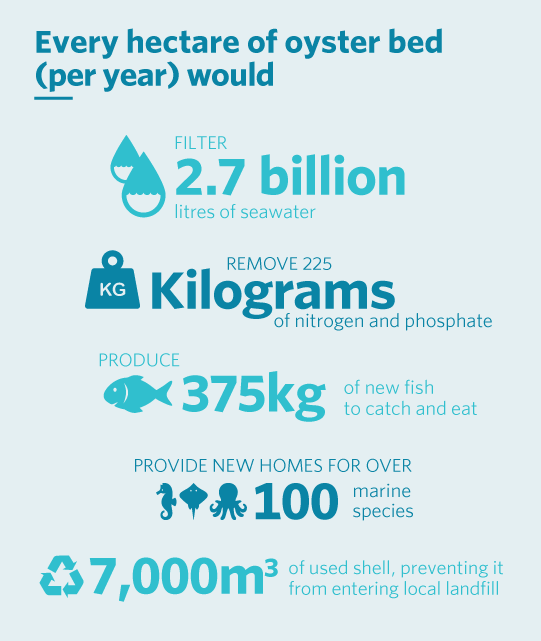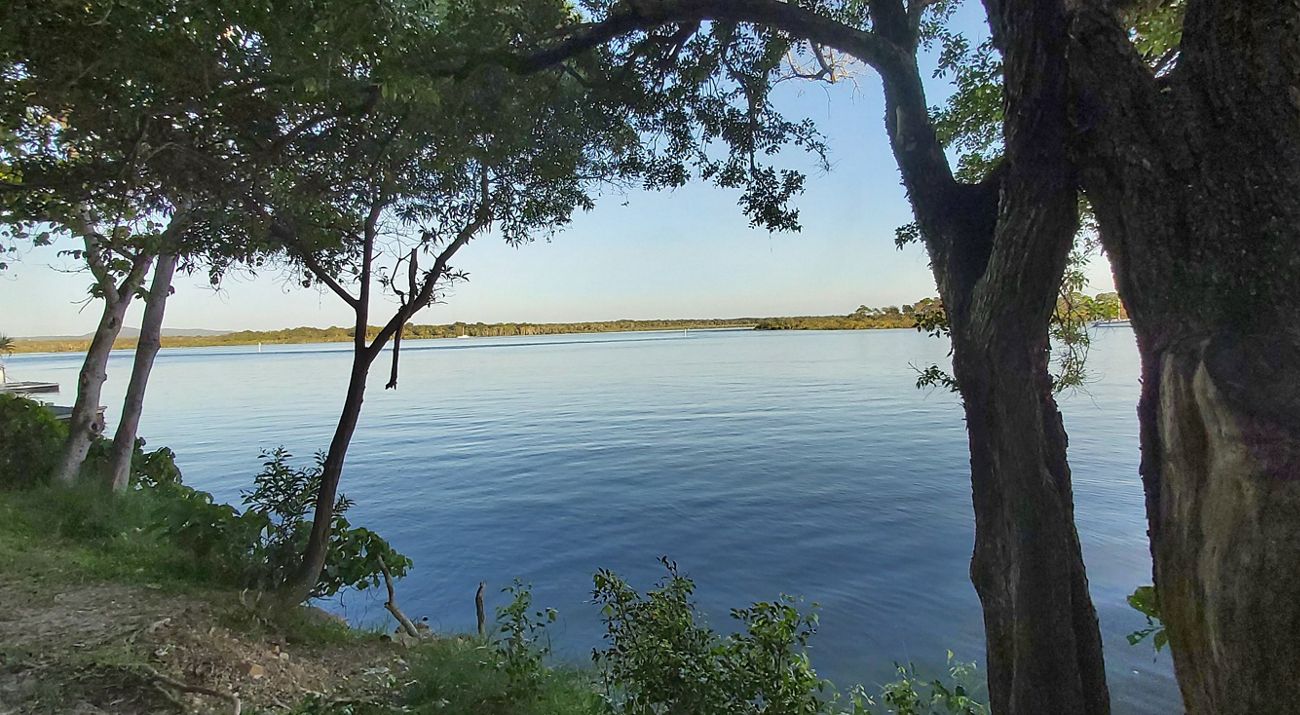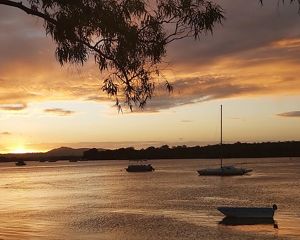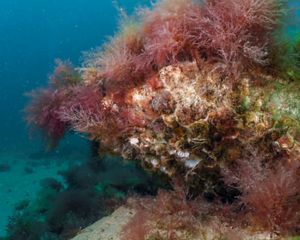Noosa River's Huon Mundy Oyster Reefs
Frequently Asked Questions
Noosa Oyster Ecosystem Restoration Project
Introduction to us, the project and partners
- Who is The Nature Conservancy?
- What is our vision for the Noosa Estuary?
- What is the Noosa Oyster Ecosystem Restoration Project?
- Why Noosa?
- Why oysters?
- How did this project evolve?
- Who is involved and how?
- How are the Kabi Kabi People involved in this project?
Processes and implementation
- How much does this project cost and who are the funders?
- Where are the restoration sites?
- What are the oyster restoration steps?
- When does the construction start?
- How will river-users know where the oyster restoration areas are?
- What is the shell recycling project: Shuck Don't Chuck?
Outcomes
Who is The Nature Conservancy?
We’re a global environmental non-profit non-government organisation working to create a world where people and nature can thrive. We’re proud to be very action-oriented in our approach to conservation. With more than 400 scientists working across 76 countries, we’ve been tackling some of our most important environmental challenges. In Australia, for the past 15 years, we’ve supported the conservation of around 130 million hectares of Australia’s lands and waters. Click here to learn more about our impact.
What is our vision for the Noosa Estuary?
Our vision is for a clean and productive Noosa River estuary. An estuary that is home to vibrant, living, oyster-dominated ecosystems. Oyster ecosystems provide abundant fish and a rich diversity of life for the benefit of nature and the Noosa community.
What is the Noosa Oyster Ecosystem Restoration Project?
The Project is a part of Australia’s largest marine restoration initiative—to return shellfish ecosystems from the brink of extinction. Research has found that 85% of the world’s shellfish ecosystems have been lost. We want to help these critically endangered ecosystems by restoring shellfish reefs at 60 locations. Noosa is our sixth project so far with other projects throughout Australia.
In partnership with Noosa Shire Council, this Project aims to restore shellfish ecosystems by providing the foundation for oyster reefs to recover in a natural way. The restoration work is done by restoration experts using tried and tested restoration techniques and following the principles and standards set out by the international Society for Ecological Restoration. Our restoration techniques have been used successfully for the past 25 years in Australia and around the world.
Why Noosa?
Noosa is one of Australia’s most desirable holiday and living destinations. Noosa known for its beautiful beaches, bays, river and accessible national parks, but not for its oyster reefs. Over 100 years ago, oyster reefs thrived in the Noosa River estuary. They were of immense social and cultural importance for generations of Kabi Kabi People and an economic resource for early European settlers to the region.
By the early 1900s, changing land and river use practices in the Noosa catchment disrupted ecological processes. This ultimately lead to the collapse of the oyster reefs. Today, Noosa’s oyster reefs are functionally extinct and unable to restore themselves. The surviving oysters we see attached to pylons, rock walls and jetties, are not complex ecosystems.
The Noosa community prides itself on caring for the environment. Being part of a community program that strives to do more, and with its deep connection to the natural environment gives this project a high likelihood of success. A deeply imbedded local passion and spirit means there is a will to support good work and to be at the cutting edge of environmental management.

Why oysters?
The wild oysters used in this project are Sydney rock oysters (Saccostrea glomerata). They’re endemic to Australia and can be found in the sheltered estuaries and bays of Hervey Bay in Queensland, and as far south as Wingan Inlet, Victoria. Sydney rock oysters are ecosystem engineers.
They form complex structures which provide surfaces, cracks and crevices for other animals and plants to colonise. By providing this type of habitat, oyster ecosystems add to the diversity and abundance of marine wildlife.
The more biodiversity and abundance in an estuary, the more stable, healthy and productive it is. Oysters also provide a range of ecosystem benefits, such as filtering river water and, in places, protecting shorelines.
How did this project evolve?
This project grew from a range of initiatives, firstly with a proposal from The Thomas Foundation and the Noosa Parks Association.
Below highlights the activities undertaken and organisations involved:
- Noosa River Expert Workshop, Powerhouse Museum, 2014
A two-day workshop, hosted by The Nature Conservancy on behalf of The Thomas Foundation and Noosa Parks Association. The workshop involved 12 academics, non-government organisations and estuary scientists. The workshop identified 14 conservation activities that could lead to a healthier Noosa River. Shellfish ecosystem restoration was listed as a priority action in addition to prawn restocking and Kin Kin sediment management (The Keep it Kin Kin Project). These activities (including further scoping studies) were later jointly funded by the Noosa Shire Council, Noosa Parks Association, The Thomas Foundation and the Noosa Biosphere Reserve Foundation.
- The Nature Conservancy Oyster Restoration Scoping Study, 2015
Our expert team, with the consulting firm Ecological Service Professionals Pty Ltd, on behalf of the Noosa Shire Council and others, undertook a five-month ecological assessment. We surveyed oyster densities across 11 intertidal and subtidal sites within the Noosa River estuary. The study confirmed high densities of oysters and good oyster recruitment particularly around Weyba Creek, the main channel around Tewantin, and in the narrow channel between Goat Island and Noosa North Shore. The project recommended installing several pilot reefs for further assessment.
- The University of Queensland Historical Ecology of Noosa Estuary fisheries, 2015
Dr Ruth Thurston, from the University of Queensland, undertook a historical ecology study on our behalf and The Noosa Shire Council. The study was to develop an understanding of historical fisheries productivity including shellfish in the Noosa River. The study confirmed shellfish ecosystems used to exist in the Noosa estuary, were used for generations by the indigenous Kabi Kabi People, and were commercially harvested in the early 1900s. The research also found that fish populations were also significantly larger than they are today.
- The University of the Sunshine Coast, Bring Back the Fish, 2018 - 2020
A three-year research study, led by the University of the Sunshine Coast and supported by the Noosa Biosphere Research Foundation, which installed a series of experimental ‘reef units’ consisting of coir bags filled with oyster shell at 14 sites across the Noosa estuary. The project studied the structural integrity of the coir bags, oyster recruitment, fish and invertebrate communities and human interactions with the reef units.
During the project, most of the coir bags showed good recruitment of oysters and other marine life. However, most bags were irreversibly damaged by anchors, disintegrated quickly or became buried in sediment. Unfortunately, the coir bags were deemed unsuitable as a restoration substrate. Learnings from this research have advised the design and implementation of our oyster restoration project.
Our project is a result of all the abovementioned organisations who came together. These groups were and remain interested in improving the sustainability and resilience of the Noosa River. This led to the creation of this Project.
Who is involved and how?
- Ecologists – Scientists work together to decide where the best places are in the Noosa estuary to restore oyster reefs and decide how the rock and shell foundations of the oyster reefs should be laid to attract wild oysters and other marine life.
- Engineers – Specialists who assure the oyster reefs foundations provide a stable base for marine life.
- Government regulators and technical advisors – Experts in ecology, biosecurity, regulation and Indigenous People come together as the project’s Technical Advisory Group. This select group helps the project managers navigate the government regulations and advise the project on all aspects of its work—acting as a brain-trust for the project.
- Local schools and community groups – Local schools and community groups with an interest in ecology, nature and sustainability, assist the project as citizen scientists and help educate the wider community about the important role of oyster ecosystems.
- Local stakeholders and residents – Boaties, fishers, conservationists, businesses and residents provide important insights to the unique character of the Noosa River estuary and how it’s used. They advise the project as to the best places to restore oyster reefs so that they fit with the ‘ebb and flow’ of today’s uses of the estuary.
- Project managers – Coordinate all aspects of the restoration, research, monitoring and communications in collaboration with working teams.
How are the Kabi Kabi People involved in this project?
Our project is located on Kabi Kabi Sea Country. The project is guided by the Kabi Kabi Traditional Owners who provide cultural knowledge and collective memories of the Noosa River and Lakes region and advise our restoration work accordingly.
How much does this project cost and who are the funders?
Our Project has a budget of $3.6m. The Nature Conservancy, The Thomas Foundation and Australian Marine Conservation Society donated $1.2m. Another, $1.2m was generously provided by Noosa’s visionary ratepayers through the Noosa Shire Council’s environment budget. An extra $1.2m was recently announced, funded from the $20 million Australian Government Reef Builder Project.
Where are the restoration sites?
The project team and local stakeholders select the restoration sites from a range of sites that have been assessed as highly suitable for oyster ecosystem restoration. Four sites will be restored in this construction phase. These sites are found in the main river channel - one at Tewantin, along the southern shoreline of Goat Island and two sites in lower Weyba Creek (Noosa Sound East and West).
What are the oyster restoration steps?
The process of oyster ecosystem restoration involves enhancing natural environmental processes which occur naturally in an estuary. Oysters are already found in the Noosa River estuary, but there is no suitable foundation for them to settle on to build complex oyster ecosystems. We just need to give them a helping hand to get started.
- Step 1 – Plan, Plan, Plan
The project team determines if the estuary environment today is still suitable for restoring oyster ecosystems. They undertake an extensive Restoration Suitability Modelling process and consult extensively with experts and stakeholders. This ensures all sites selected for oyster restoration are the ‘best fit’ for both oysters and people. The team gathers all relevant information and present this in readily accessible ways for different audiences. - Step 2 – Sourcing local rock and recycling cured oyster shells
The project uses rock and dried (cured) oyster shells to form the foundation of the oyster reefs. The rock is sourced locally, and the oyster shells are collected from shellfish wholesalers and retailers.
Once laid in the river, the foundation sits up to 50cm above the sediment. At this height, the oysters, and other marine life, are well exposed to good water flow and food (phytoplankton, zooplankton) as well as sunlight. This mimics the natural processes of ecosystem building that would otherwise be formed by generations of oysters and other marine animals, colonising a hardened rough surface on the estuary bed.
There are plenty of wild oysters in the Noosa estuary. These will naturally colonise the new oyster reefs. We also have the option of seeding the oyster reefs with hatchery-reared oysters to give the restoration process a ‘kick start’. Oyster ‘seeding’ gives oysters an initial competitive advantage over other species, such as barnacles, algae, mussels and marine plants, who compete for space on the rocky bed. Oyster seeding is planned for spring (October) 2022.
- Step 3 – Deploy the substrate into the river
Starting in late July 2022, local contractors will deploy the rock onto the Noosa estuary floor at the selected restoration sites. The contractors use a barge and long reach excavator to lay the rock exactly according to the plans provided by ecologists and engineers. These plans have been approved by government.
- Step 4 – Monitor, Evaluate, Report
Scientists, working with local scientific contractors, apply tried and tested monitoring systems to establish a baseline of data at and around the restoration sites. They also identify a ‘target reference ecosystem’ to which comparisons can be made as the oyster ecosystems establish.
Once the rocky oyster bed bases are laid into the water, scientists measure how many oysters colonise the oyster reef, as well as other species present. The results are collated annually and reported to government, stakeholders, the community and funders.
The project team regularly evaluates the results, restoration and monitoring methods and project costs. Adjustments are made using adaptive management techniques. This ensures the team are using the most effective and efficient restoration methods.
How does the ecosystem form and how long does it take?
The shape and mix of species in any given oyster ecosystem, or oyster reef, varies depending on the physical characteristics of the growing environment. Each oyster ecosystem is strongly influenced by tidal heights, the composition and shape of the riverbed, water flow characteristics and human interactions (level of extraction or interference).
Some oyster reefs respond to their location by growing upwards. Some stay low and spread out, forming beds or patches of oysters. Oyster reefs may be interspersed with patches of sandy sediments, seagrass, mangroves or rocky reefs.
Read below to discover how an oyster ecosystem grows:
- Years 1 - 3 Rock and oyster shell base in place on the riverbed. Oyster larvae settle and grow on the base. Marine plants, other oyster species and invertebrates start to colonise. Fish and other species visit the site.
- Years 3 - 5 Oysters mature and spawn. Second generation of oyster larvae colonise the rock and shell in the young forming ecosystem. Fish such as bream, flathead and stingrays regularly visit the oyster reef.
- Years 5 - 10 Multiple generations of oysters now growing on the oyster reef. The oyster reef increases in size and productivity. A range of fish, invertebrates and marine plants now live permanently, or seasonally, on and around the oyster reef.
- Years 10 onward The oyster reef is a diverse, abundant and self-propagating ecosystem.
When does the construction start?
The ecosystem restoration will start in late July 2022 and continue for up to three months.
How will river-users know where the oyster restoration areas are?
The contractor will be installing navigational markers (yellow buoys) in the river at the outward edges of the reefs, both up and downstream. These markers will be clearly marked as a “restoration area”. The Nature Conservancy will be working closely with local businesses and agencies to ensure that river users are aware of where the reefs are, so that they can avoid interaction with them.
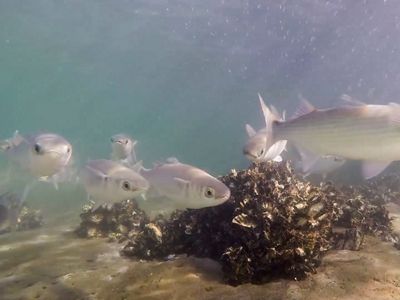
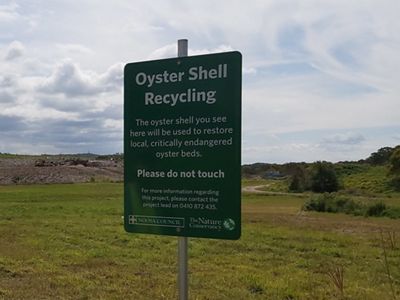
What is the shell recycling project: Shuck Don't Chuck?
Part of the restoration method uses recycled oyster shells to add to the rocky base. Some shells will be seeded with oyster larvae to fast-track ecosystem development. To support this method, we’ve established a local shell recycling program called Shuck Don’t Chuck.
How it works:
- Oyster shells are collected from local seafood wholesalers and retailers.
- Shells are sun-dried (cured) following strict biosecurity protocols to ensure they’re contaminant-free.
- Dried shells are added to the rocky base.
Adding oyster shells increases the surface area of the base and provides extra surfaces for oyster larvae to cement to. This technique has been used successfully by The Nature Conservancy around the world for more than 15 years.
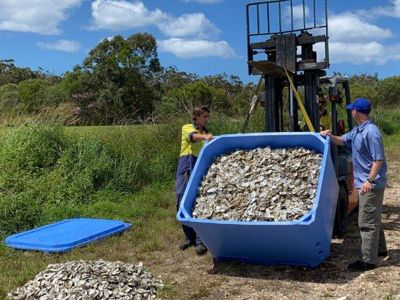
Is oyster restoration like oyster farming?
Oyster ecosystem restoration helps start the natural processes for wild oysters to colonise an area and form complex ecosystems. Ultimately, restoration aims to grow oysters to improve the natural environment, not for human consumption.
Oyster farming is a specialised form of aquaculture (or mariculture) practice in which oysters are collected and raised under controlled conditions for the purpose of producing oysters for human consumption.
While both oyster restoration practitioners and oyster farmers share some common interests, restorers work to repair complex oyster habitats to their natural, wild state. Oyster farmers, however, use natural processes to produce a commodity that is marketable and sold to consumers under strict quality assurance protocols.
Can I eat oysters off the restored reefs?
There are no regulations preventing people eating wild oysters from the restoration sites. Removing even a few oysters though, directly impacts the oyster reefs and slows their recovery.
We encourage you to support your seafood and bait suppliers by sourcing quality assured and sustainably farmed oysters from them. In doing so, you support this project.
Do oyster reefs need management long-term?
Once mature, oyster reefs are self-sustaining. But they need space to flourish with minimal human disturbance. Long-term management of the oyster reefs requires signage, so people know where the oyster reefs are, and public awareness to help minimise impacts to the oyster reefs and the wider restoration area.
By treating Noosa’s oyster reefs as valuable habitats and nurseries, they will return benefits to the environment and community for generations to come.
How long will the project take?
The initial restoration work takes 3 to 5 years. Monitoring and reporting on the performance of the oyster reefs may continue well beyond this timeframe depending on resources.
The Noosa Oyster Ecosystem Restoration Project is implemented in three phases to reduce ecological and financial risks.
Phase 1: Optimal design and siting (2020) pre-planning to determine the optimal design, locations and most cost-effective method of shellfish ecosystem restoration.
Phase 2: implementation (2020-2021) restoration of the oyster reefs at two sites in the estuary to fine-tune the restoration methods, designs, and check that the most cost-effective systems are in place.
Phase 3: Scaled up restoration (2021-2022) more restoration substrate is added in the estuary at all suitable and approved sites.
The application of an adaptive management framework at each stage of the project, whereby learnings from previous stage are included in the planning of future stages, is central to this risk management approach.
What does this mean for me?
A healthier, more resilient estuary! Just like a coral reef in the ocean, a restored network of living, thriving oyster reefs in the Noosa River would:
- filter water,
- offer protective nursery havens for young fish,
- enhance biodiversity and fisheries productivity,
- help build the resilience of the river to human uses and natural impacts
